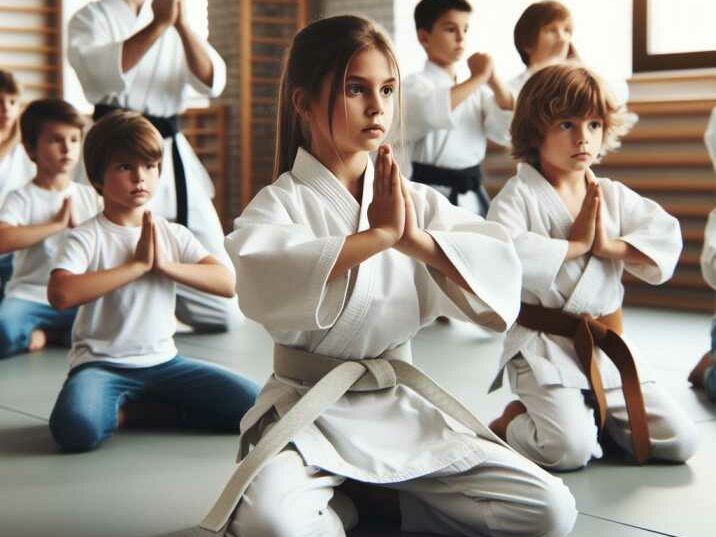Introduction
Table of Contents
Welcome to our deep dive into the science behind fitness gains through martial arts for kids! Have you ever wondered why martial arts are so beneficial for children? This comprehensive blog post will explore the incredible physiological benefits of martial arts provide, such as increased muscle mass, bone density, and cardiovascular health. Join us as we uncover how these activities contribute to the overall well-being and development of young athletes.

Table of Contents
- Introduction
- Benefits of Increased Muscle Mass
- Enhancing Bone Density
- Boosting Cardiovascular Health
- Physiological Benefits of Martial Arts
- Psychological Benefits of Martial Arts
- Social Benefits of Martial Arts
- Nutritional Considerations for Young Martial Artists
- Safety Measures in Martial Arts for Kids
- Role of Parents in Supporting Martial Arts Training
- Conclusion
- Frequently Asked Questions (FAQs)
Benefits of Increased Muscle Mass
How Martial Arts Increase Muscle Mass
Martial arts, such as karate, judo, and taekwondo, are exceptional for developing muscle mass in kids. When children engage in these activities, they perform various movements, including punches, kicks, and throws. These movements require the use of multiple muscle groups, which, over time, leads to muscle growth and strengthening.
Resistance Training Effect: Martial arts involve bodyweight exercises that act as resistance training, crucial for building muscle mass. Push-ups, sit-ups, and squats are commonly integrated into martial arts routines, helping to enhance muscular strength.
Dynamic Movements: Unlike traditional weightlifting, martial arts involve dynamic and functional movements. This means children are not just building muscle; they are also improving their muscle coordination and functional strength.
Benefits of Increased Muscle Mass for Kids
- Improved Strength: As children build muscle, they become stronger, which helps them in daily activities and boosts their confidence.
- Better Metabolism: Increased muscle mass boosts metabolism, helping children maintain a healthy weight.
- Enhanced Performance: With stronger muscles, kids can perform better in other sports and physical activities.
- Postural Improvements: Stronger muscles support better posture, which is beneficial for growing children and helps prevent back problems later in life.
- Injury Prevention: Enhanced muscle mass provides better support for joints, reducing the risk of injuries during physical activities.
Enhancing Bone Density
The Role of Martial Arts in Bone Health
Bone density refers to the amount of bone mineral in bone tissue, and it’s crucial for overall bone health. Martial arts play a significant role in improving bone density, especially during the critical years of childhood and adolescence.
Weight-Bearing Exercises: Many martial arts activities are weight-bearing exercises. Movements like jumping, kicking, and striking place stress on the bones, which stimulates bone formation and increases bone density.
Impact Activities: The impact from controlled falls, strikes, and landings in martial arts also promotes bone growth and strength. These activities encourage the body to deposit more minerals into the bones, making them stronger.
Long-term Benefits of Enhanced Bone Density
- Reduced Risk of Osteoporosis: Building strong bones during childhood helps reduce the risk of osteoporosis in later life.
- Injury Prevention: Strong bones are less prone to fractures and injuries, which is particularly important for active kids.
- Healthy Growth: Enhanced bone density supports healthy growth and development during the crucial growth spurts in childhood and adolescence.
- Improved Balance: Strong bones and muscles improve balance and coordination, reducing the likelihood of falls and related injuries.
- Better Athletic Performance: Kids with higher bone density and strong bones can perform better in various physical activities and sports.
Boosting Cardiovascular Health
Cardiovascular Workouts in Martial Arts
Cardiovascular health is critical for overall wellness, and martial arts are excellent for keeping the heart healthy. The intense and varied workouts in martial arts get the heart pumping and improve cardiovascular fitness.
Aerobic and Anaerobic Exercises: Martial arts include both aerobic (long-duration, low-intensity) and anaerobic (short-duration, high-intensity) exercises. Activities like sparring, forms, and drills improve heart and lung function, enhancing cardiovascular health.
Interval Training: Many martial arts classes incorporate interval training, which alternates between high-intensity activities and periods of rest. This type of training is highly effective for cardiovascular conditioning.
Benefits of Cardiovascular Health for Kids
- Improved Heart Function: Regular cardiovascular exercise strengthens the heart, improving its ability to pump blood efficiently.
- Increased Stamina: Better cardiovascular health leads to increased stamina, allowing children to engage in physical activities for longer periods without fatigue.
- Enhanced Mental Health: Cardiovascular exercise releases endorphins, which are known to improve mood and reduce stress, benefiting children’s mental health.
- Weight Management: Regular cardio workouts help in maintaining a healthy weight by burning excess calories and improving metabolism.
- Better Academic Performance: Improved cardiovascular health has been linked to better concentration and cognitive function, which can enhance academic performance.
Martial Arts and Overall Physical Fitness
Comprehensive Physical Development
Martial arts provide a well-rounded physical workout, contributing to overall physical fitness. It combines strength, flexibility, balance, and coordination, which are all essential components of physical fitness.
Flexibility and Balance: Martial arts involve stretching and balance exercises, which enhance flexibility and prevent injuries. Techniques like high kicks and stances improve balance and coordination.
Core Strength: Martial arts routines often emphasize core strength, as a strong core is essential for balance and powerful movements. Exercises like sit-ups and various martial arts techniques target the abdominal and lower back muscles.
Holistic Benefits of Martial Arts
- Discipline and Focus: Martial arts teach discipline and focus, which are beneficial in all areas of life, including academics.
- Social Skills: Training in martial arts often involves group activities, helping children develop social skills and make new friends.
- Self-Defense Skills: Learning self-defense techniques can increase a child’s confidence and sense of security.
- Stress Relief: The physical activity and mental focus required in martial arts provide an excellent outlet for stress relief, helping children manage anxiety and emotional challenges.
- Enhanced Coordination: Martial arts improve hand-eye coordination and motor skills, which are beneficial for overall physical development and other sports.
Physiological Benefits of Martial Arts
Building Confidence and Self-Esteem
Martial arts training helps children develop a sense of achievement and self-worth. As they progress through different belts and master new techniques, their confidence grows.
Achievement through Progression: The belt ranking system in martial arts provides clear goals for children. Achieving a new belt level boosts their self-esteem and motivates them to continue improving.
Developing Discipline and Focus
Martial arts require significant discipline and focus, which translate into other areas of life. Kids learn to set goals, work hard, and stay committed, skills that are valuable in both academics and personal development.
Mindfulness and Concentration: Martial arts teach children to be present and focused. This mindfulness helps improve concentration in school and other activities.
Managing Stress and Emotions
Martial arts provide a constructive outlet for managing stress and emotions. The physical exertion and mental focus required in training sessions help kids release pent-up energy and frustration.
Emotional Regulation: Through regular practice, children learn to control their emotions, handle stress, and respond to challenges calmly and effectively.
Social Benefits of Martial Arts
Teamwork and Respect
Martial arts training often involves working with partners or in groups, fostering a sense of teamwork and mutual respect. Kids learn to cooperate with others and understand the importance of respecting their peers and instructors.
Cultural Awareness: Many martial arts disciplines are rooted in rich cultural traditions. Learning about these traditions helps children develop an appreciation for different cultures and histories.
Developing Leadership Skills
As children advance in martial arts, they often take on mentoring roles for younger or less experienced students. This experience helps them develop leadership skills and confidence in guiding others.
Responsibility and Accountability: Being a part of a martial arts community teaches children about responsibility and accountability, as they are often required to help maintain the dojo and assist in classes.
Nutritional Considerations for Young Martial Artists
Importance of a Balanced Diet
For kids involved in martial arts, proper nutrition is crucial. A balanced diet ensures they have the energy and nutrients needed for intense physical activity.
Macronutrients: Ensure that kids get a balanced intake of carbohydrates, proteins, and fats. Carbohydrates provide energy, proteins are essential for muscle repair and growth, and healthy fats support overall health.
Micronutrients: Vitamins and minerals are also vital. Calcium and vitamin D are essential for bone health, while iron supports oxygen transport in the blood.
Hydration and Recovery
Proper hydration is vital for young martial artists. Ensure they drink enough water before, during, and after training sessions to prevent dehydration and support recovery.
Post-Workout Nutrition: After training, consuming a snack with protein and carbohydrates helps replenish energy stores and aids in muscle recovery. Examples include a banana with peanut butter or a smoothie with yogurt and fruit.
Safety Measures in Martial Arts for Kids
Ensuring a Safe Training Environment
Safety is paramount in martial arts training. Parents and instructors must ensure a safe environment where children can practice without undue risk of injury.
Proper Equipment: Ensure that children use appropriate protective gear, such as mouthguards, gloves, and shin guards, during sparring and other contact activities.
Qualified Instructors: It is essential to have qualified and experienced instructors who prioritize safety and teach proper techniques.
Injury Prevention and Management
Despite the best precautions, injuries can occur. Knowing how to prevent and manage them is crucial.
Warm-Up and Cool-Down: Incorporate proper warm-up and cool-down routines to prepare the body for physical activity and reduce the risk of injuries.
Recognizing Injuries: Teach children to recognize the signs of common injuries, such as sprains and strains, and encourage them to report any discomfort or pain immediately.
Role of Parents in Supporting Martial Arts Training
Encouraging Consistent Practice
Parents play a vital role in supporting their children’s martial arts journey. Encouraging consistent practice helps children progress and gain the full benefits of training.
Positive Reinforcement: Celebrate achievements and milestones to keep children motivated and enthusiastic about their training.
Balancing Martial Arts with Other Activities
While martial arts are beneficial, it’s essential to balance them with other activities and responsibilities.
Time Management: Help children manage their time effectively so they can balance martial arts with schoolwork, other sports, and leisure activities.
Providing Nutritional Support
Ensure children have a nutritious diet to support their physical activities. Involve them in meal planning and preparation to teach healthy eating habits.
Healthy Snacks: Provide healthy snacks and meals that fuel their bodies and support their training needs.
Conclusion
The science behind fitness gains in martial arts for kids is truly fascinating. From increasing muscle mass and enhancing bone density to boosting cardiovascular health, the benefits are extensive and impactful. Martial arts not only contribute to physical fitness but also promote mental and emotional well-being, making it a fantastic activity for children. By encouraging kids to participate in martial arts, parents can help them build a strong foundation for a healthy, confident, and successful future.
Frequently Asked Questions (FAQs)
1. At what age can children start martial arts?
Children can start martial arts as early as 4 years old, but it depends on the specific martial art and the child’s readiness.
2. Are martial arts safe for kids?
Yes, martial arts are generally safe for kids when taught by qualified instructors who emphasize proper technique and safety.
3. How often should kids practice martial arts?
Kids should practice martial arts 2-3 times a week to see significant benefits while avoiding overtraining.
4. Do martial arts help with weight management?
Yes, martial arts can help with weight management by providing a high-energy workout that burns calories and builds muscle.
5. What are some popular martial arts for kids?
Popular martial arts for kids include karate, taekwondo, judo, and Brazilian jiu-jitsu, each offering unique benefits and techniques.


